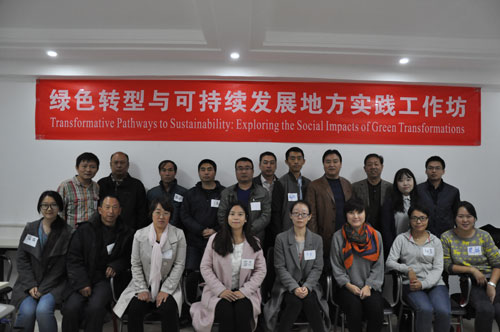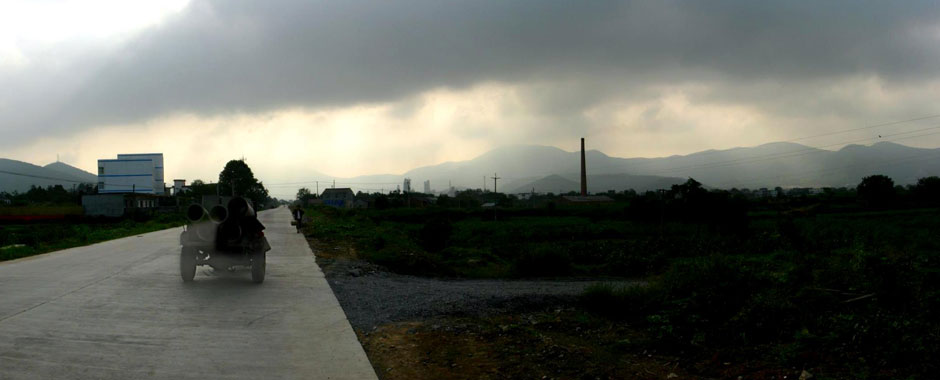pA transformation lab (T-Lab) focused on China’s green transformation policy and its impacts was held in Shijiazhuang City, Hebei Province on October 22, 2016. The T-lab intended to identify problems created through the implementation of local “green transformation” policies and sustainable pathways for the future. It was entitled “Transformative pathways to sustainability: Exploring the social impacts of green transformations” and was sponsored by the International Social Science Council (ISSC) and co-hosted by the STEPS Centre and School of Social Development and Public Policy, Beijing Normal University.
The transformation labs are processes that involve many stakeholders, such as local governments and non-governmental actors, to develop solutions to respond to a sustainability problem. They aim to bring about transformative pathways to sustainability by learning across disciplines, contexts and cultures. They aim to generate innovations that can overcome specific problems and fixed ways of doing things by developing strategies that test out many different innovations and solutions.
The T-lab in Hebei Province focused on the social impacts of China’s long-term ambitious policy plan to become more environmentally sustainable. China’s 13th Five Year Plan, which runs from 2016 to 2020 promotes low carbon industries, green finance, environmental monitoring and CO2 emission permit systems. It also sets out a number of initiatives to reduce smog and air pollution and carbon dioxide emissions.
In the past two years, the implementation of the government’s green transformation policy has led, in part, to a crack-down on air pollution in Jingjinji area, where two important cities, Beijing and Tianjin, are located. Hundreds of cement factories in the area have been shut down. For example, in December 2013, there were over 100 privately owned cement factories in Luquan, a district in southwestern Shijiazhuang, Hebei province, which has a number of private and state-owned cement factories employing thousands of workers. Since then, 24 privately-owned cement factories in Luquan have shut down with a loss of 2,500 jobs, according to a Luquan government report.
The T-lab brought together different stakeholders involved in the policy implementation process, with the aim of listening to and better understanding each other’s different concerns. Officials from Luquan District Government Office, Bureau of Industry and Information Administration and town government officials, laid-off cement factory workers, university scholars, as well as journalists and workers of non-governmental environmental protection organisations participated in the workshop. By promoting dialogue and understanding among the different groups, the T-lab aimed to develop more sustainable pathways that benefit different stakeholders.

Participants analysed and discussed questions including: the reasons for the green transformation and its impacts on different groups, their major concerns with the green transformation process and the challenges and opportunities the transformation has brought to them.
During the discussion, it was recognised that different stakeholders had different concerns. For example, many factory workers previously working in privately-owned cement factories have been laid-off. The closures have had a huge impact on their lives, as they now have little job security and survive by carrying out odd jobs. They were mainly concerned about receiving retraining and about securing employment.
Local government officials at the workshop are facing unprecedented pressure because of persistent local high unemployment and the decline in financial revenue from taxes collected from local cash-strapped businesses. They focused their comments on concerns about the economy, insufficient local job opportunities and the importance of introducing alternative industries in order to replace the closed down cement factories.
Journalists and non-governmental environmental protection organisations attending the workshop were concerned about the government continuing to maintain its focus on becoming more environmentally sustainable as part of its Five year plan. Therefore, their discussion focused on whether the green transformation policy was being fully implemented, how it could achieve its expected objectives, as well as what kind of supporting policies and actions could be put in place by the local government to direct and promote employment.
Researchers were very interested in the policy-making process. They asked whether the social impacts of the policy had been adequately considered during the policy-making process, and how the negative social impacts inadvertently caused by the policy could be addressed by the government.
According to these widely diverse concerns on green transformation, participants were divided into four groups to discuss and propose different policy suggestions from their own perspectives. Those suggestions included providing additional unemployment insurance to laid off workers for a specific period of time, providing occupational training to laid off workers so that they could have some new skills, developing alternative sources of income, such as agriculture to support the planting and breeding industry. Participants were also asked to think about what policy proposals they would make if time and money was no limit. Some participants said, “more scientific and practical environmental policies should be developed”. Others said “central transfer payments should also support green transformation projects.” Others said the government should “develop some community activities and policies so that laid off workers could get involved in community activities which could help relieve stress and make them feel “calm”, particularly during the recession. They also suggested that the government should “develop the evaluation and feedback mechanism of social cost to green transformation, particularly focusing on the social impact”.
At the end of the workshop, participants gave their feedback about the T-lab process. One participant said, “each position in the society has its necessity. Listening to each others’ voices will create a more harmonious society”. Another said, “public communication with mutual trust is good for positive interaction.”
In the case of Luquan District, the voices of laid-off cement factory workers were heard and shared. Apart from the importance of sharing the stories of participants affected by the policies, participants realised that there were a lot of groups that had been neglected during the process. It was agreed that China’s green transformation should not only consider environmental factors and economic factors, but also social factors. It was agreed that it was important to consider the potential impact of any reforms on different stakeholders’ during the policy-making process. Participants were then inspired with more sustainable and long-term development pathways by describing and characterising the dominant system and current policies. Participants then discussed sustainable and long-term development pathways after analysing China’s current policies.
The green transformation lab is only the first step in this process. Researchers from Beijing Normal University will keep in contact with workshop participants and other stakeholders involved. By carrying out participatory observations and in-depth interviews, we will keep tracking changes to arise from this green transformation lab. We are planning the second transformation lab in 2018, with the aim of observing any changes, such as the development of new district government policies and actions or measures that could be used to support laid off cement workers in Luquan. Meanwhile, some preparation and communications work will be done to ensure the next transformation lab in 2018 will go smoothly.
This event was one of a series of Transformation Labs (T-Labs) held as part of our project on Transformations to Sustainability around the world. Find out more about the project.
